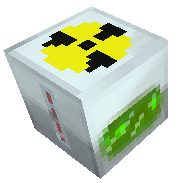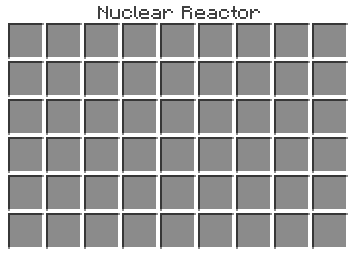Nuclear Reactor: Difference between revisions
No edit summary |
No edit summary |
||
| Line 25: | Line 25: | ||
|A1=Redstone|B1=Advanced Circuit|C1=Redstone | |A1=Redstone|B1=Advanced Circuit|C1=Redstone | ||
|A2=Wooden Plank|B2=Generator|C2=Wooden Plank | |A2=Wooden Plank|B2=Generator|C2=Wooden Plank | ||
|A3= | |A3=Redstone Repeater|B3=Iron Furnace|C3=Redstone Repeater | ||
|Output=Nuclear Reactor | |Output=Nuclear Reactor | ||
}} | }} | ||
Revision as of 12:34, 18 October 2012
| Nuclear Reactor | |
|---|---|
 | |
| Information | |
| Type | Generators |
| Mod | Industrial Craft |
| Gravity | No |
| Luminance | No |
| Blast Resistance | ? |
| Tool | ? |
| Stackable | Yes (64) |
The Nuclear Reactor is a known generator to produce EU.
With IndustrialCraft², the reactor system is fully recoded! Instead of lame Uranium refining, you now have to make a good setup for your reactor with all the reactor stuff you can find in the navigation. But one thing wasn't completely changed: nuclear meltdowns!
In IC² the reactor can hold a value of heat, which is a byproduct of producing energy with Uranium Cells. This heat can be reduced by Cooling Cells, and Integrated Heat Dispersers.
You can enlarge the space of your reactor by attaching up to 6 additional Reactor Chambers.
Recipe
GUI
This is the new GUI (fully upgraded with 6 additional Reactor Chambers):


Don't think about using them as a mad scientist's large chest; a reactor will spit out any item that is unrelated to its function. (Other than empty buckets.)
Usage
Reactors are complex and not for the faint of heart. A bad design can suddenly replace your house with a nice new crater.
Contents
Reactor Terms
Here are some of the terms often used when describing a reactor and its design.
- Reactor Tick
- A reactor 'ticks' once every second. This is when heat, EU generation, and cooling is calculated.
- Reactor Design
- The pattern in which components are placed within a reactor. A good design can give you nice, safe energy, and a bad design can spontaneously crater-ize your home and its contents.
- Full Cycle
- The time it takes for a full Uranium Cell to be used up. 10,000 reactor ticks, or 2 hours 47 mins.
- Uranium Pulse
- Pulses occur during a reactor tick, producing heat and EU for each Uranium Cell. Uranium Cells placed next to each other will interact to produce multiple pulses per reactor tick.
- Heat
- The reactor itself and its components can all store heat. If heat levels gets too high, then components will melt, and there will be a risk of a reactor meltdown. (Boom!)
- Cooling
- Cooling is provided by internal components like a Cooling Cell and the outside environment like water. Cooling is needed to counteract the effects of heat and hopefully keep your reactor (and home) intact.
- Cooldown Period
- The time required for an inactive reactor to cool all the excess heat it has collected.
- Reactor Hull
- This is where heat goes when it's not stored in a component. The maximum heat storage is 10,000EU, but it can be increased with Reactor Chambers and Integrated Reactor Plating.
- Reactor Class
- All reactor designs can be a class like "Mark-I-O ED" or "Mark-III EB" which gives an indication of how well a design will perform.
- Reactor Efficiency
- The average number of pulses per Uranium Cell. (efficiency = pulses / cells)
The more Uranium Cells that are placed next to each other, the higher the efficiency, but also the higher the risk.
- Breeder Reactor
- A type of reactor design that produces little energy. Its purpose is to recharge Depleted Isotope Cells into full Uranium Cells.
Reactor Components
A list of the various components that can be used within a reactor.
- Reactor Chamber
- Not really an internal component, these are placed adjacent to the reactor block in order to increase the number of slots within a reactor, increase the strength of the hull (+1000), and add a small amount of cooling.
- Uranium Cell
- The key part of a reactor. Each cell will pulse one or more times per tick, producing some heat and 200 EU. On its own, a cell will only pulse once (10 EU/t) per tick, but each adjacent Uranium Cell will add an additional pulse per tick, producing additional heat and packets of 200 EU. A Uranium Cell will last up to 10,000 reactor ticks (2 hours 47 minutes), generating anywhere between 2,000,000 to 10,000,000 EU, depending on the efficiency of the design. Uranium Cells have a chance to turn into Near-Depleted Uranium Cells when they're used up.
- Cooling Cell
- A single cell can store up to 10,000 heat away from the reactor hull; any more heat will cause the cell to melt. The cell will also cool 1 point of its stored heat each reactor tick.
- Integrated Reactor Plating
- Plating will distribute heat from an adjacent uranium cells into surrounding cooling cells and also into other plating to be further distributed. Distributing heat to another plating only happens once; the second plating will not distribute to a third plating. Plating also increases the reactor's hull strength (+100) and can store up to 10,000 heat itself if it is unable to direct it into a cooling cell. This stored heat will dissipate at a rate of 0.1 per reactor tick.
- Integrated Heat Disperser
- These components will attempt to balance out the levels of heat within the reactor hull, itself, and any adjacent component capable of storing heat. During each tick a disperser can exchange up to 25 heat with the reactor hull and up to 6 heat with each of the surrounding components.
- For example, if a reactor hull has 120 heat stored and fresh disperser is placed inside and surrounded by 4 cooling cells, then the disperser will begin balancing the heat levels until the hull, itself, and the cooling cells each have 20 heat.
- Near-Depleted Uranium Cell
- The 'empty' state of a Uranium Cell; these can be made manually, or have a chance of appearing when a Uranium Cell runs dry within a reactor. They produce 1 heat each reactor tick.
- Depleted Isotope Cell
- A depleted Uranium Cell mixed with coal dust. When placed next to a Uranium Cell it recharges into a full cell once again. Isotope cells produce 1 heat and will cause adjacent Uranium Cells to pulse an additional time each tick. This extra pulse will produce heat but not EU. Isotope cells charge much faster if the reactor is running very hot.
- Re-Enriched Uranium Cell
- The fully charged state of an isotope cell, it will continue to produce only 1 heat and no EU but it will no longer react with adjacent uranium cells. Combined with another coal dust, it will become a brand new Uranium Cell.
- Water Bucket
- When a reactor's hull has more than 4000 heat, it will evaporate the water, reducing the heat level by 250 and leaving the empty bucket behind. (The reactor won't spit it out.)
- Ice Block
- Each reactor tick, if a reactor's hull has more than 300 heat, it will evaporate 1 ice block, reducing the heat level by 300.
- Lava Bucket
- A lava bucket will increase a reactor's hull heat level by 2,000, and the empty bucket will remain in the reactor. This is useful for 'breeder' type reactors while recharging isotope cells.
Reactor Classification
All reactor designs fall into a set of pre-defined categories. This makes it easier to see, at a glance, how effective a design can be when either looking up designs on the IC forums or posting a design yourself.
Mark III
Mark III reactors tend to have an emphasis on efficiency at the cost of safety. Mark IIIs are unable to complete a full cycle without going into meltdown and thus need to be shutdown mid-cycle in order to deal with the high amount of excess heat. This can be done manually or by using Redstone.
Mark IIIs have the additional condition that they must run at least 10% of a cycle (16 mins 40 secs) before reaching critical heat or losing any components.
Mark V
Mark Vs are for those who want to squeeze every last scrap of EU from their uranium cells; they cannot run long without needing a cool down period. You'd better have great Redstone timer skills, or you'll never be able to turn your back on these things.
Additional Suffixes
As well as being Mark I to V, reactor designs also have one or more suffixes to better inform people about their performance.
- Single Use Coolants
- A reactor that relies on a supply of ice and/or water buckets in order to maintain its classification should be suffixed with '-SUC'.
- Efficiency
- To calculate efficiency, take the number of uranium pulses a design makes per tick and divide it by the number of uranium cells it possesses.
- The number provided will show the efficiency rating a design has:
Number Rating Exactly 1 EE Greater than 1 but less than 2 ED 2 or greater but less than 3 EC 3 or greater but less than 4 EB 4 or greater EA
- Breeder
- This suffix is for designs that also recharges isotope cells. Isotope cells charge up faster when the reactor runs hot, so heat management is important. There are three breeder types:
- Negative-Breeders slowly lose heat over time and will need heat to be added manually, or they can be left for a safe slow way to recharge isotopes.
- Equal-Breeders have exactly the same heat generation as they do cooling ability and usually only require a user to boost the reactor's heat level manually at the beginning.
- Positive-Breeders gain heat over time and will require more precise cool down management for the reactor to remain hot.
- Reactors whose sole purpose is to recharge cells may not even have a 'Mark' classification and are simply called Breeders instead, with the efficiency/SUC suffix added.
Heat Ticks Required 0-2,999 40,000 3,000-5,999 20,000 6,000-8,999 10,000 Over 9000! 5,000
Example Classifications
- Mark I-O EE
- A reactor design that can run continuously, but relies on outside cooling and only produces one pulse for each Uranium Cell.
- Mark II-1 ED Positive-Breeder
- A reactor with recharging capabilities that can only run one full cycle before needing a cool down.
- Mark II-2 EC
- A reactor design that can run two full cycles before needing a cool down period, producing at least 2 pulses per Uranium per reactor tick on average.
- Mark II-E-SUC EC
- A reactor that can run at least 16 times before needing a cool down, relying on a supply of ice or water and has average efficiency.
- Breeder EA
- A heat-neutral reactor designed for the sole purpose of recharging Isotope Cells. Each Uranium Cell is capable of charging 3 or more Isotope Cells.



